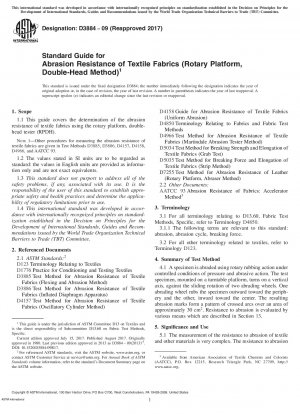ASTM D3884-09(2017)
Standard Guide for Abrasion Resistance of Textile Fabrics (Rotary Platform, Double-Head Method)
- Standard No.
- ASTM D3884-09(2017)
- Release Date
- 2009
- Published By
- American Society for Testing and Materials (ASTM)
- Status
- Replace By
- ASTM D3884-22
- Latest
- ASTM D3884-22
- Scope
-
5.1 The measurement of the resistance to abrasion of textile and other materials is very complex. The resistance to abrasion is affected by many factors, such as the inherent mechanical properties of the fibers; the dimensions of the fibers; the structure of the yarns; the construction of the fabrics; and the type, kind, and amount of finishing material added to the fibers, yarns, or fabric.
5.2 The resistance to abrasion is also greatly affected by the conditions of the tests, such as the nature of abradant, variable action of the abradant over the area of specimen abraded, the tension of the specimen, the pressure between the specimen and abradant, and the dimensional changes in the specimens.
5.3 Abrasion tests are all subject to variation due to changes in the abradant during specific tests. The abradant must accordingly be discarded at frequent intervals or checked periodically against a standard. With disposable abradants, the abradant is used only once or discarded after limited use. With permanent abradants that use hardened metal or equivalent surfaces, it is assumed that the abradant will not change appreciably in a specific series of tests. Similar abradants used in different laboratories will not change at the same rate, due to differences in usage. Permanent abradants may also change due to pick up of finishing or other material from test fabrics and must accordingly be cleaned at frequent intervals. The measurement of the relative amount of abrasion may also be affected by the method of evaluation and may be influenced by the judgment of the operator.
5.4 The resistance of textile materials to abrasion as measured on a testing machine in the laboratory is generally only one of several factors contributing to wear performance or durability as experienced in the actual use of the material. While “abrasion resistance” (often stated in terms of the number of cycles on a specified machine, using a specified technique to produce a specified degree or amount of abrasion) and “durability” (defined as the ability to withstand deterioration or wearing out in use, including the effects of abrasion) are frequently related, the relationship varies with different end uses, and different factors may be necessary in any calculation of predicted durability from specific abrasion data. Laboratory tests may be reliable as an indication of relative end-use performance in cases where the difference in abrasion resistance of various materials is large, but they should not be relied upon where differences in laboratory test findings are small. In general, they should not be relied upon for prediction of actual wear-life in specific end uses unless there are data showing the specific relationship between laboratory abrasion tests and actual wear in the intended end-use.
5.5 These general observations apply to all types of fabrics, including woven, nonwoven, and knit apparel fabrics, household fabrics, industrial fabrics, and floor coverings. It is not surprising, therefore, to find that there are many different types of abrasion testing machines, abradants, testing conditions, testing procedures, methods of evaluation of abrasion resistance and interpretation of results.
5.6 All the test procedures and instruments that have been developed for abrasion resistance of fabrics may show a high degree of variab
ASTM D3884-09(2017) Referenced Document
- ASTM D123 Standard Terminology Relating to Textiles
- ASTM D1776 Standard Practice for Conditioning and Testing Textiles
- ASTM D3885 Standard Test Method for Abrasion Resistance of Textile Fabrics (Flexing and Abrasion Method)
- ASTM D3886 Standard Test Method for Abrasion Resistance of Textile Fabrics (Inflated Diaphragm Apparatus)
- ASTM D4157 Standard Test Method for Abrasion Resistance of Textile Fabrics (Oscillatory Cylinder Method)
- ASTM D4158 Standard Guide for Abrasion Resistance of Textile Fabrics (Uniform Abrasion)
- ASTM D4850 Standard Terminology Relating to Fabrics and Fabric Test Methods
- ASTM D4966 Standard Test Method for Abrasion Resistance of Textile Fabrics (Martindale Abrasion Tester Method)
- ASTM D5034 Standard Test Method for Breaking Strength and Elongation of Textile Fabrics (Grab Test)
- ASTM D5035 Standard Test Method for Breaking Force and Elongation of Textile Fabrics (Strip Method)
- ASTM D7255 Standard Test Method for Abrasion Resistance of Leather (Rotary Platform, Abraser Method)
ASTM D3884-09(2017) history
- 2022 ASTM D3884-22 Standard Guide for Abrasion Resistance of Textile Fabrics (Rotary Platform Abrader Method)
- 2009 ASTM D3884-09(2017) Standard Guide for Abrasion Resistance of Textile Fabrics (Rotary Platform, Double-Head Method)
- 2009 ASTM D3884-09(2013)e1 Standard Guide for Abrasion Resistance of Textile Fabrics 40;Rotary Platform, Double-Head Method41;
- 2009 ASTM D3884-09(2013) Standard Test Method for Abrasion Resistance of Textile Fabrics (Rotary Platform, Double-Head Method)
- 2009 ASTM D3884-09 Standard Guide for Abrasion Resistance of Textile Fabrics (Rotary Platform, Double-Head Method)
- 2007 ASTM D3884-07 Standard Guide for Abrasion Resistance of Textile Fabrics (Rotary Platform, Double-Head Method)
- 2001 ASTM D3884-01(2007) Standard Guide for Abrasion Resistance of Textile Fabrics (Rotary Platform, Double-Head Method)
- 2001 ASTM D3884-01e1 Standard Guide for Abrasion Resistance of Textile Fabrics (Rotary Platform, Double-Head Method)
- 2001 ASTM D3884-01 Standard Guide for Abrasion Resistance of Textile Fabrics (Rotary Platform, Double-Head Method)
- 1992 ASTM D3884-92 Standard Guide for Abrasion Resistance of Textile Fabrics (Rotary Platform, Double-Head Method)

Copyright ©2024 All Rights Reserved